Key Features
- Compliant with Version 1.4a of the HDMI Compliance Test Specification
- Dedicated signal pull-up termination provided by TF-HDMI-3.3V enables full bandwidth testing using cables
- Simple and easy-to-use automated testing
- Powerful and flexible analysis tools offer unmatched insight for diagnosing and solving elusive problems
- Support for all clock rates described in Version 1.4a of the specification
- Connection diagrams help to make sure that you get the right setup on the first try
- QualiPHY report generation creates comprehensive reports with all pertinent test information
The QPHY-HDMI software package for the WaveMaster/SDA/DDA 8 Zi Oscilloscopes provides a concise set of validation/verification and debug tools written in accordance with version 1.4a of the High Definition Multimedia Interface (HDMI) electrical test specifications. HDMI test modes covers amplitude, timing and jitter parameters.
In addition to standard eye pattern and jitter tests for HDMI, the SDA real-time test equipment platform provides a complete set of amplitude and jitter measurements, as defined in the HDMI specification. This combination of measurements makes QPHY-HDMI a cost-effective, compelling HDMI solution.
Once a problem is detected, all of the power SDA tools are at your disposal to help find the root cause.
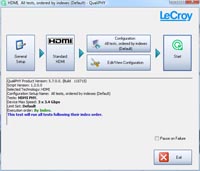
QPHY-HDMI provides a highly automated and easy-to-use solution for HDMI transmitter testing in accordance with Version 1.4a of the HDMI Compliance Test Specification
QPHY-HDMI Makes Compliance Testing Easy
Typically, compliance testing is a very difficult task. The user must make the necessary connections between the oscilloscope and the device under test, manually configure the oscilloscope for the appropriate measurement, perform the test procedure as specified by the test specification, record the results and finally compare the results to the appropriate limit in the compliance specification. QPHY-HDMI does all of these steps for you automatically after indication of the correct connection to use.
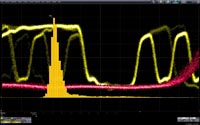
This image is showing a measurement of VL level (Test 7-2). C1 is triggered at the end of an H-L-L-L bit sequence. F2 is a zoom on the last L-L bits. P3 is the most frequent level of those L-L bits.
Comprehensive and Easy-to-read Test Reports
Measurement results often need to be summarized and tabulated to quickly verify specifications. This information, together with instrument and signal acquisition/test condition setups, results in a fully documented record. QPHY-HDMI streamlines this process by incorporating an automatic HTML report generation engine. The created test reports contain tabulated numerical values for each individual test result, including PASS/FAIL and specification limit columns. Reports can also be saved as PDF, HTML or XML.
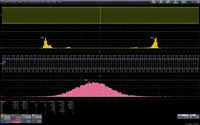
This image is a measure of Clock Rise Time (Test 7-4). F4 is the Clock. F1 is the histogram of F4 vertical levels. The two peaks correspond to base and top, they are used to compute the 20% and 80% levels. Z1 is a zoom of F4 showing the computed levels. P6 is a measure of F4 rise time at these levels. F2 is the histogram of P6 and P7 is the mode of F2, final measure as specified by the standard.
Advanced Debug Capability
If a compliance failure is found, Teledyne LeCroy's SDA II serial data analysis package is available to help find the root cause quickly and easily. SDA II has the ability to perform Eye and Jitter measurements simultaneously and is fully integrated into the oscilloscope application software. In addition, SDA II provides insight into the measured Eye and Jitter parameters making is easier to identify the sources of problems.
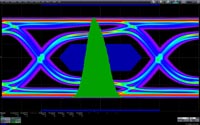
This image is a measure of the Eye Diagram (Test 7-10). The eye is validated against the mask as defined by the standard.
QualiPHY
QualiPHY has many predefined configurations that allow users to run complete compliance test. In addition, users can create their own custom test groups and limit sets. When the tests are complete, QualiPHY will generate a full test report in PDF, HTML, or XML formats (including eye diagrams and other screenshots).
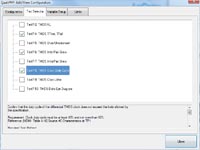
QualiPHY has many preset compliance configurations but also enables users to create their own configuration and limit sets.
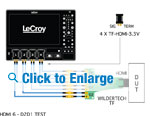
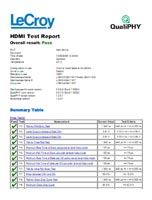
HMDI Test Results Report.
TF-HDMI-3.3V
The TF-HDMI-3.3V adapter provides the necessary 3.3 V pull-up termination for HDMI testing. The TF-HDMI-3.3V provides both a signal path through to the oscilloscope with a 3.3 V pull-up termination as well as an input that is directly terminated to 3.3 V. This is required for terminating the data lines that are not currently under test. The TF-HDMI-3.3V-QUADPAK provides four adapters and 8 SMA-SMA cables to allow for the testing of all HDMI signals (Clock, D0, D1 and D2).
TF-HDMI-3.3V Quick Reference Guide
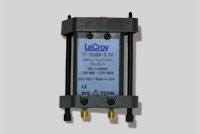
TF -HDMI-3.3 V adapter provides the necessary 3.3 V pull-up termination for HDMI testing.
Specifications
Supported Tests from Version 1.4a of the High Definition Multimedia Interface Compliance Test
- 7-2 TMDS — VL
- 7-4 TMDS — TRise, TFall
- 7-5 TMDS — Over/Undershoot (Not Mandatory)
- 7-6 TMDS — Inter-Pair Skew
- 7-7 TMDS — Intra-Pair Skew
- 7-8 TMDS — Clock Duty Cycle
- 7-9 TMDS — Clock Jitter
- 7-10 TMDA — Data Eye Diagram